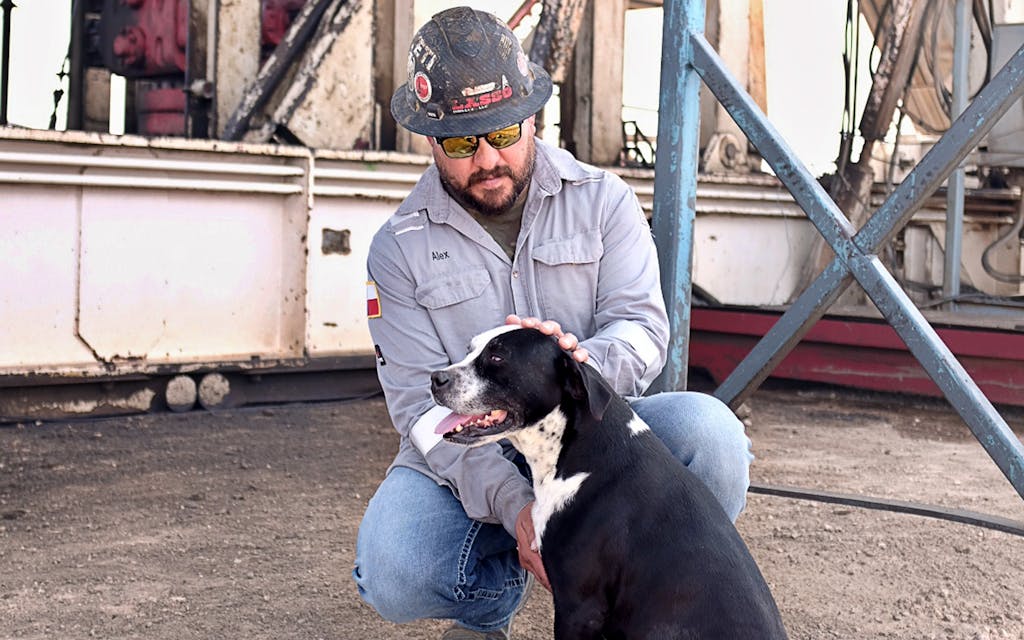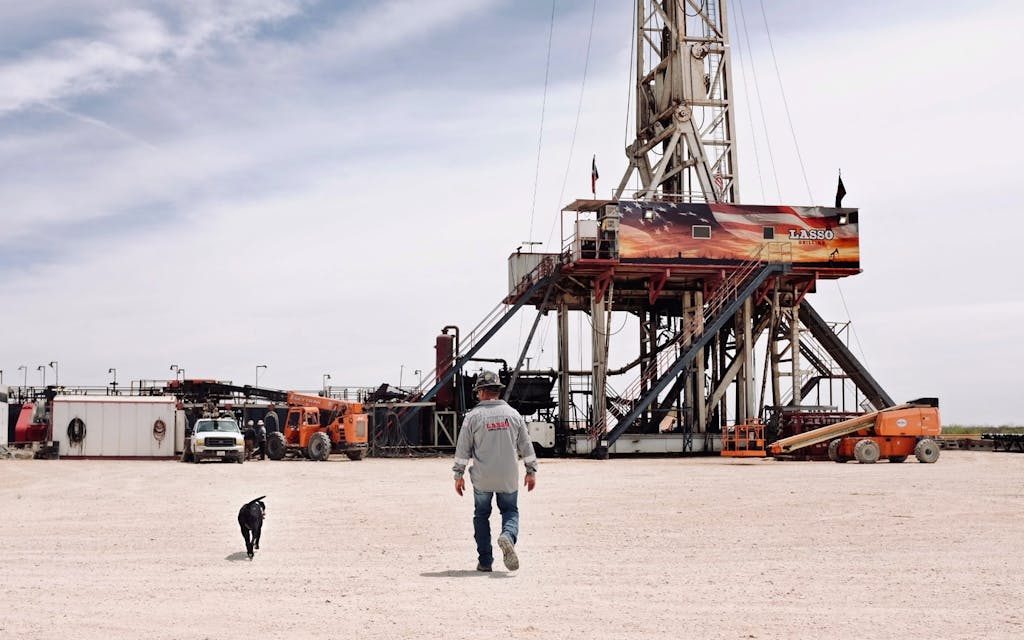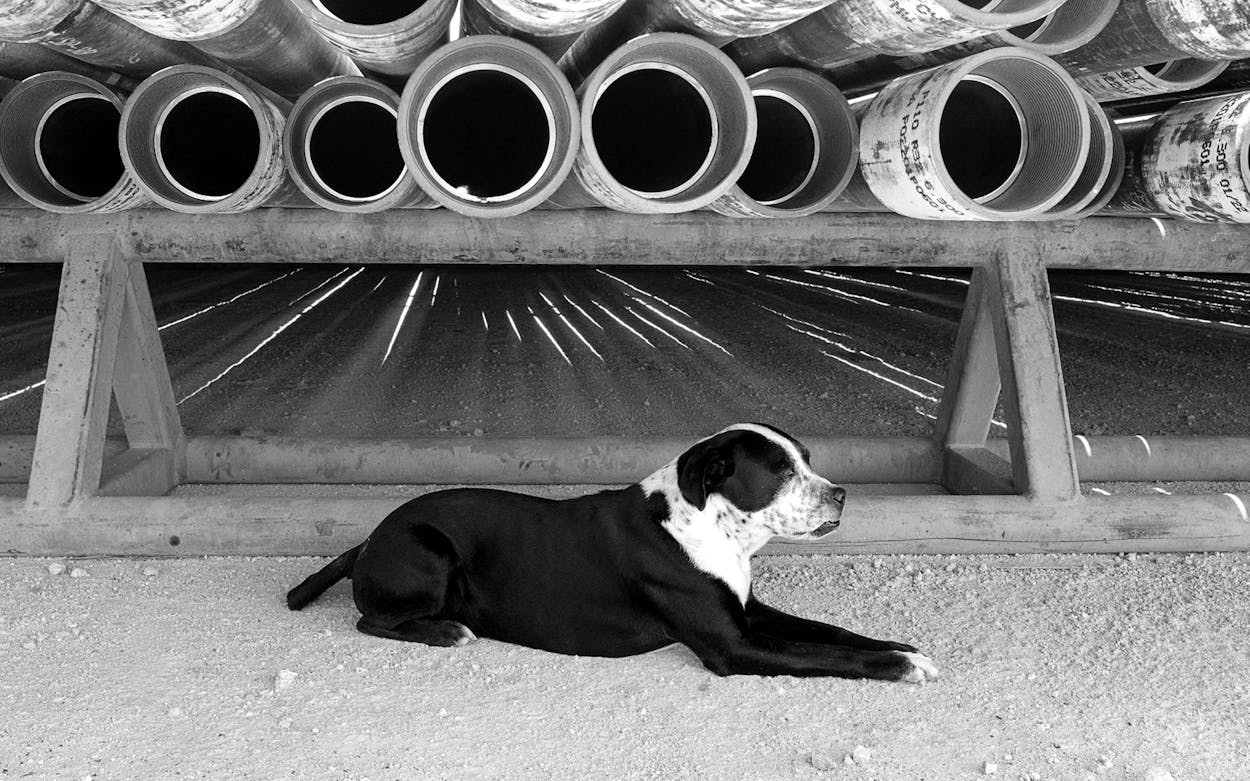Good help can be hard to find in the oil patch these days, which is why Bruno stands out. He has a sunny disposition and doesn’t complain when shifts run long. He’s intelligent and a good problem solver. He is loyal and possesses an uncanny ability to steer clear of the hundreds of hazards on a modern drilling rig. He has avoided injury on the job and has never needed to file a workers’ compensation claim.
Unlike many of his coworkers, he delights in swapping the comforts of his house in Midland for life in a trailer in some dusty corner of Andrews or Loving County. He prefers being far from town, where he can encounter rabbits, javelinas, and rattlesnakes. To him, those critters are sources of fascination and amusement.
In short, Bruno is a good boy. A very good boy. He’s a rig dog—a black, short-haired mutt with a distinctive white stripe running from the nape of his neck over his head and between his eyes before spreading across his muzzle. His lip curls up slightly on one side, creating a rakish scowl, as if he’s an actor in a Hollywood gangster movie from the forties.
Bruno belongs to Alex Reyna, manager of Lasso Drilling rig number 103. The day I visited his work site, Reyna sat on a couch with his legs stretched before him while Bruno sniffed at his size-12 Crocs decorated with pictures of cartoon characters Stan and Cartman from South Park. “A lot of us are away from home for a long time. Dogs, they kind of, I wouldn’t say substitute for your family, but they’re something other than just work,” Reyna says.
On the hardest, most stressful days, when a vital piece of electronic equipment isn’t working and the rig sits idle, making Lasso Drilling lose out on hundreds of thousands of dollars in revenue, Bruno understands his job. “He jumps and starts licking your face,” Reyna says. “I calm down immediately.”
He started taking Bruno to the rig as a puppy, and he kept right on bringing him back again and again, aside from a few months when a manager for a former employer—ironically, Big Dog Drilling—told everyone to leave their dogs at home.
It’s not uncommon for rig crews to adopt stray dogs that wander in for table scraps and decide to stick around. With skilled workers hard to come by, especially lately because of the nationwide labor shortage, many oil and gas companies have relaxed their pet policies.
Yet dogs have been part of Texas oil-field life for as long as there have been Texas oil fields. In 1926, the well that launched the Hendrick oil field, in Winkler County, came in with such a roar that the driller’s dog took off running and didn’t return until the next day, according to the caption on a historical photograph in the University of Texas Libraries collection.
Thanks to improved operational efficiency over the years, each rig now requires fewer workers, which helps reduce costs but adds to a crew’s feeling of isolation. Rigs are surrounded by miles of emptiness. Last fall there were about 350 drilling rigs in the Permian Basin, an area the size of Utah.
So dogs such as Bruno serve an important function as companions on lonely jobsites. Which is why the day Bruno disappeared, Reyna was distraught. His dog was missing in an inhospitable region, and the trailer was way too empty without him.
To reach Lasso 103, I drove west out of Kermit, the seat of Winkler County, west of Odessa, for about 45 minutes into the heart of the Permian Basin. At some point, I entered Loving County, the least populous in the country. New Mexico was nearby. Up ahead, a ten-story, blue-and-white drilling rig came into view, an island in a sea of brush. Near it sat a cluster of mobile homes, where about two dozen workers live during their two- to three-week-long shifts. They punch holes in the earth for long hours at a stretch, then retire to their separate double-wides to eat and sleep.
I’d come to talk about that day in late October 2020, when Reyna and the Lasso 103 crew were drilling in Andrews County, about ten miles east of the county seat, and the mercury fell to 27 degrees. Reyna had come down from the rig floor—a platform about thirty feet off the ground where roughnecks thread pipe segments together as the drill bit devours rock far underfoot—and went to his trailer to let Bruno out. But when it came time for Reyna to return to work, the dog didn’t want to go inside, despite the freezing rain.
“I got to go upstairs. You’ll have to tough it out,” Reyna told him.
An hour or so later, Reyna looked for Bruno from atop the rig floor—which offers a good view of the drilling outpost and the surrounding area—but didn’t see him anywhere. He figured Bruno had cadged some sympathy and was sleeping inside someone’s heated trailer, but he got shrugs from one coworker after another as he went door to door. No one had seen him.
Bruno would leave the immediate vicinity of the rig to relieve himself or to chase rabbits, but during bad weather, he usually stayed close. “I was worried,” Reyna says. On cold days, sometimes a coyote would come close to the camp and yap at the rig dog, hoping to draw him into a chase out into the mesquite, where a second coyote was hiding. Together, the coyotes could outmatch a lone dog.

Reyna walked around the rig in concentric circles, first tightly around the machinery, then ten yards farther out, then another ten. Bruno’s paw prints were everywhere, but none led away from the rig. To Reyna’s relief, there weren’t any coyote tracks.
Rig dogs learn to associate the sounds and smells of oil drilling with friendly scratches and the workers who feed them pieces of sandwiches and occasional hunks of ribeye. If Bruno had ventured upwind of the distinctive smell of diesel mixed with the earthy dankness of drilling mud, and strayed far enough away to no longer hear the thrum of the diesel generators, he could have lost track of the rig.
Reyna’s theory is that he was interested in another dog, Miley, who’d come to the jobsite in the truck of a drill-bit salesman the morning Bruno disappeared. Maybe he had followed the pickup (and Miley) down the lease road for a bit, saw a rabbit, and chased it. Maybe that chase led to another rabbit, and before long he was lost.
In the hours after Bruno’s disappearance, Reyna got a list of who had made deliveries to the rig that morning and called them. He reached Matt Hamilton, the bit salesman, who was sympathetic. “I can only imagine what Alex was thinking,” he recalled. “You’re out in the middle of nowhere. The dog feels normal. . . . It’s your family.” Hamilton promised to keep an eye out and ask around.
Over the years, West Texas had become Bruno’s playground. Reyna would watch him from the rig floor as the dog tore through the mesquite after rabbits. He moved swiftly, like a gazelle. Reyna even once saw him chase a bobcat, which he fortunately couldn’t catch. Bruno’s familiarity with the land and its inhabitants was the only thing that gave Reyna any comfort.
A few hours after Bruno went missing, Reyna called his wife to tell her he couldn’t find Bruno. “I got an earful,” he told me. His youngest son had picked Bruno out as a puppy in 2010 and named him after singer Bruno Mars, who then owned pop radio with his hits “Grenade” and “Just the Way You Are.”
A day after Bruno disappeared, Reyna’s wife traveled to the rig, and together they drove around the lease yelling his name. “He’s smart,” Reyna told her. “He’ll dig a hole. He won’t freeze. I promise.” But he wasn’t so sure. West Texas can prove perilous even in good weather, and that week was cold and wet.
Reyna passed word about Bruno on social media and scoured a website featuring lost pets. Office workers at his employer wrote about the missing dog on LinkedIn, and friends posted photographs on Facebook. These efforts generated a roller coaster of emotions as reports of potential sightings turned out to bring false hope. Reyna got calls from scammers asking him to send money to pay for gas to return Bruno. “Are you kidding me? Are you holding him for ransom?” he remembers thinking.
Reyna also reached out to the loose fraternity of operators, salesmen, and contractors who work on the region’s rigs. Over the years, hundreds of oil-field workers had befriended Bruno. Word spread across a dozen counties. Reyna ran into a friend at a grocery store whom he hadn’t seen in a year who asked him if he had found his dog.
Yet nothing came of it. “I thought I was going to get divorced. My kids hated me,” he said. Nine days into the ordeal, the animal shelter in Andrews reported holding a couple of black-and-white dogs, so Reyna drove there to look. Neither was Bruno. He stood outside the shelter thinking it might be time to let go.
Then his phone chirped with a text.
On the day he disappeared, Bruno likely headed in an east-southeasterly direction, away from the town of Andrews and into a flat expanse of fences, wellheads, and the occasional frac pond. He might have dug a hole in which to rest while protected from the wind, but there’s no record of how Bruno survived the eight days until he came across a familiar smell: an oil rig churning its way into the earth.
It was Helmerich & Payne rig number 551. He wandered into the drilling outpost, scrawnier than he had been when he left Reyna’s trailer and its steady supply of Hill’s Science Diet food. Otherwise, he was in good shape after traveling fifteen miles as the crow flies.
The crew of the rig fed Bruno, and he seemed comfortable there. He could have stayed indefinitely, but a day or two after he showed up, Matt Hamilton—Miley’s owner—spotted him. Bruno was up on the rig floor, near where the roughnecks were joining pipes and not far from the control room, universally known in the oil field as the doghouse. (The term once applied to any small, cooplike structure where oil-field workers could take shelter from the weather. The workers themselves were the dogs.)

Hamilton told the rig crew that he recognized Bruno. They weren’t thrilled with the information. “When I told those guys I knew who owned him, they told me, ‘No way, he’s our rig dog,’ ” he recalled. Hamilton snapped a photograph at the time. In it, Bruno is casually lying down, his paws stretched out and touching one another. He texted it to a friend, who texted it to Reyna. Parked outside the Andrews pound, Reyna received the photo. “I’m COMING BRUNO,” he texted back. He got in his truck and hightailed it eastward. On the way, he called his wife, who started crying with joy.
Reyna pulled into the Helmerich & Payne drilling site, and before he parked, he saw Bruno. “Sure as s—, he is laying in front of the company man’s trailer on a mat. And I go, ‘Bruno, what are you doing, man?’ ” Bruno lifted his head and trotted over.
Reyna was ecstatic and introduced himself to the company man—the well owner’s representative on a rig—who made it clear he liked Bruno and wanted him to stay. But Reyna was firm that he was taking his dog. “I hate to see him go, but if you ever want to get rid of him, you can bring him back,” the company man told him. Reyna loaded Bruno into his truck and drove off. After a couple miles, he stopped and FaceTimed his family.
This was a couple of years ago. Bruno is now twelve, and while he still gets excited when he sees Reyna packing his pickup at their home to head out to begin another shift, he sleeps much of the time on a four-foot-square blue pillow. His days on the rig floor are over. “He won’t go up there hardly ever,” Reyna tells me. Sometimes, when the air-conditioning in the trailer is too cold, he suns himself outside. Bruno, not Reyna.
Reyna also takes another dog to work now, a curly-haired fellow named Bo. He was named after Bo Diddley, but the family started calling him Bo Dirty after he came home from the rig caked in dirt. “He’s a rig dog now; he’s a working dog,” Reyna says. “He’s not a house dog anymore.”
For two weeks at a spell, Reyna’s life is confined to a couple of dusty acres. He is a long drive from his wife, children, and friends. Having a dog by his side is as important to keeping the operations moving as a full tank of diesel and a high-performance drill bit. I asked what would happen if new management came and changed the liberal dog policy. Reyna thought for a minute. “I think what I’ll do is I’ll go to the doctor and get a prescription” for Bruno, he said. “I’ll convert him over to a service dog.”








